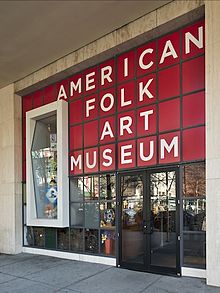American Folk Art Museum

American Folk Art Museum
|
|
| Established | June 23, 1961 |
|---|---|
| Location | 2 Lincoln Square , Manhattan, New York, United States |
| Coordinates | 40°45′42″N 73°58′41″W / 40.7616°N 73.9781°WCoordinates: 40°45′42″N 73°58′41″W / 40.7616°N 73.9781°W |
| Director | Dr. Anne-Imelda Radice |
| Public transit access | Subway: 1, 66 Street - Lincoln Center; Buses: M5, M7, M11, M20, M66, M104 |
| Website | www |
The American Folk Art Museum is an art museum in the Upper West Side of Manhattan, at 2, Lincoln Square, Columbus Avenue at 66th Street. It is the premier institution devoted to the aesthetic appreciation of folk art and creative expressions of contemporary self-taught artists from the United States and abroad.
Its collection holds over 7,000 objects from the 18th century to the present. These works span both traditional folk arts and the work of contemporary self-taught artists and European Art Brut. In its ongoing exhibitions, educational programming, and outreach, the museum showcases the creative expressions of individuals whose talents developed without formal artistic training.
Admission is free. In 2013, the museum had record attendance with over 100,000 visitors.
Since receiving a provisional charter in 1961, the American Folk Art Museum has continually expanded its mission and purview. At its inception, the museum lacked a permanent collection, an endowment, and a building. Despite lacking these institutional fixtures, founding Trustees Joseph B. Martinson and Adele Earnest had a vision: the advancement of the understanding and appreciation of American folk arts. In the museum’s fifty-year history, this dedication has held true. The museum’s evolving mission reflects the shifting understanding of American folk art in the contemporary American society.
The Museum of Early American Folk Arts, as it was known initially, held its first exhibition in a rented space on 49 West 53rd Street in 1961. The museum’s collection was launched in 1962 with the gift of a gate in the form of an American flag, celebrating the nation’s centennial. The gift reflected the museum’s early focus on eighteenth and nineteenth-century vernacular arts from the northeast America.
In 1966, after receiving a permanent charter, the museum expanded its name and mission. As the Museum of American Folk Arts, it looked beyond the traditional definitions of American folk art. Its exhibitions and collection began to reflect “every aspect of the folk arts in America – north, south, east, and west.” Founding curator, Herbert W. Hemphill Jr., “expanded the notion of folk art beyond traditional, utilitarian, and communal expressions.” Under his direction, the museum began to champion idiosyncratic and individualistic artwork from the fields of traditional and contemporary folk art. In doing so, the museum ushered in a new era in the field of twentieth-century folk art. The 1990s brought new focus to the diversity and multiculturalism of American folk art. Offering a more inclusive vision, the museum began to present African American and Latino artworks in their exhibitions and permanent collections. Director Gerard C. Wertkin announced American folk art’s common heritage as “promoting an appreciation of diversity in a way that does not foster ethnic chauvinism or racial division.”
...
Wikipedia
